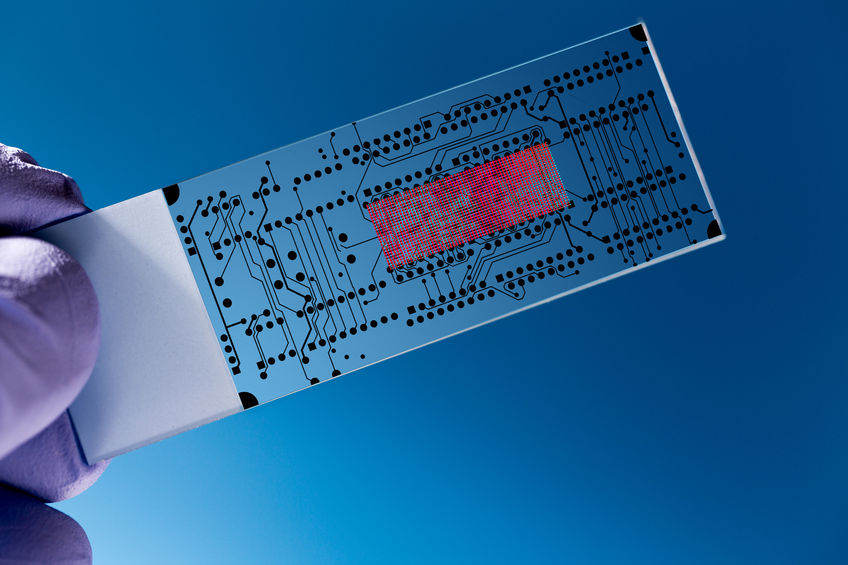 Andy Tay
Andy Tay
Biomedical engineering is a highly interdisciplinary field that integrates knowledge from physics and chemistry to solve biological problems. Although it is becoming an extremely popular field and biomedical jobs are expected to increase substantially, due to its diverse research topics, many people do not fully understand what it comprises. This article is part of a series that explains the various subject matters within biomedical engineering. Through this series, I hope to improve public understanding of this field, and potentially help students who are choosing majors and contemplating graduate education make their decisions. The first spotlight was on neural engineering. This one focuses on microfluidic diagnostics.
What is microfluidics, and how it is used in diagnostics?
Microfluidics refers to the manipulation of small amounts of fluid (10-5 to 10-9 L). Due to its small scale, microfluidics offers advantages such as low sample and reagent volume, and greater control of spatial and temporal fluid manipulation. Microfluidics have been combined with technologies such as polymerase chain reaction and nanoparticles to create biosensors for diagnostics. They are especially useful for use in developing regions, as they meet the World Health Organization’s ASSURED (affordable, sensitive, specific, user-friendly, rapid, equipment-free, deliverable to users) criteria for diagnostics.
What are some examples of microfluidic diagnostics?
 Blood draw, Processing, Detection
Blood draw, Processing, Detection
Malaria diagnosis
About 600,000 people fall victim to malaria annually. The gold-standard test for malaria uses Giemsa stains microscopy. It is very cost-effective but it has a low detection limit, and the sensitivity and specificity of the test highly depends on the technician's skills. The other most common method is rapid diagnostic testing, where malaria parasite-specific antibodies are used. Although it offers high specificity, the antibodies can degrade in humid environments, thus limiting the shelf life of the assay.
A range of microfluidic technologies has been developed for malaria diagnosis. For instance, as malaria-parasite-infected red blood cells (iRBCs) usually have lower cell deformability than healthy RBCs, these two cell populations can be separated. Hou et al. managed to make use of cell deformability as a biomarker to isolate iRBCs at different stages of malaria parasite infection.
Dielectrophoretic (DEP) forces are generated when dielectric particles (i.e. polarizable electrical insulators) such as cells are subject to direct or alternating electric fields. Gascoyne and colleagues demonstrated the possibility of using microfluidic DEP to isolate iRBCs, as the electrical conductivity of iRBCs are significantly higher than uninfected RBCs, attributing to membrane permeation pathways induced by malaria parasites.
Sepsis diagnosis
Sepsis is a serious and life-threatening complication due to infection. It is characterized by a whole-body inflammatory state (called systemic inflammatory response syndrome, or SIRS) that occurs due to chemicals secreted to fight the infection. Sepsis can lead to multiple-organ failure, shock, and death. Current diagnostic and therapeutic approaches such as physical examination, blood analysis, and molecular diagnostic techniques, unless integrated, can be suboptimal.
Mahalanabis et al. created a microfluidic-based detection system for cell lysis and DNA extraction of gram-positive and gram-negative bacteria, known causatives of sepsis, that may be coupled with PCR to construct a micro total analysis system for integrated diagnostics all in one chip. One example would be the collaboration between STMicroelectronics and Mobidiag, where they developed a lab-on-chip system for DNA-based detection of 10 sepsis-causing bacteria from positive blood-culture samples.
HIV/AIDS
HIV affects more than 40 million individuals worldwide, with about 85% of affected patients living in developing nations, and in need of an ASSURED diagnostic and antiretroviral therapy (ART) monitoring platform. HIV infection can lower the number of immune cells such as CD4+ T-lymphocytes. During ART, virus replication is suppressed, leading to gradual increase in CD4+ T-lymphocytes. Current strategies for disease detection include measurement of viral load and determination of CD4+ cell counts from blood or oral fluids.
Watkins et al. developed a biochip for CD4+ and CD8+ lymphocyte counting based on differential electrical impedance. Whole blood is introduced and RBCs are lysed, leaving a supposedly pure population of white blood cells. Target lymphocytes flowing through a microfluidic channel can generate a spike in impedance with an amplitude and width proportional to their sizes and translocation velocities as they block the flow of current. The CD4+ and CD8+ lymphocyte count closely matched results from highly sensitive (but bulky) flow cytometers, and the entire process can be performed in about 20 minutes.
Glynn and coworkers specifically isolated magnetically tagged CD4+ cells directly from patient blood by using magnetic nanoparticles coated with anti-CD4 antibodies. Instrument-free pumping was implemented by a finger-actuated elastic membrane, and tagged beads were laterally deflected by a small and reusable permanent magnet, making the instrument extremely cost-effective.
What is the future?
Mobile technology will play a key role, together with microfluidic diagnostic devices, for remote health monitoring. Therefore, electrochemical, electrical impedance, and colorimetric assays will be very useful as means for readout using cell phones. One example is a recent technology advancement using field-portable and cost-effective mobile phones for detecting nucleic acid amplification during polymerase chain reaction.
Opportunities
- The Society for Lab Automation and Screening (SLAS) offers the Tony B. Academic Travel awards for participants to present their work on microfluidic technology automation in the annual SLAS conference.
- The microTAS conference also offers a range of travel and career awards for students, postdocs and early career professionals to attend the meeting.
References: 1. A. Tay, A. Pavesi, S. R. Yazdi, C. T. Lim, M. E. Warkiani, Advances in microfluidics in combating infectious diseases. Biotechnol. Adv. 2015; 2. M. E. Warkiani, A. K. P. Tay, B. L. Khoo, X. Xiaofeng, J. Han, C. T. Lim, Lab Chip 2014, 15, 1101.
Quartzy is the world’s No. 1 lab management platform. We help scientists easily organize orders, manage inventory, and save money. We’re free and always will be. Visit Quartzy.com or reach out at info@quartzy.com.
Interested in writing for The Q? Send us an email!
Share this:

Andy Tay
Andy Tay is a graduate student in the University of California, Los Angeles and an instructor in the National University of Singapore. His research focuses on magnetic neural stimulation and magnetotactic bacteria. He enjoys science communication and using the gym in his free time.
